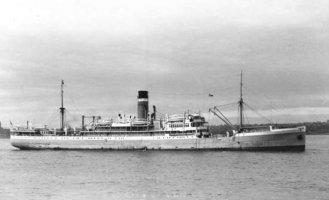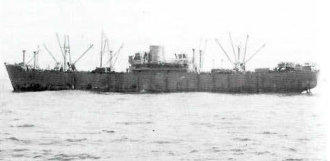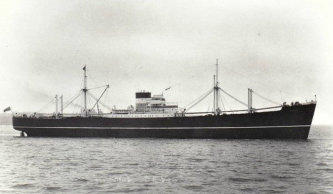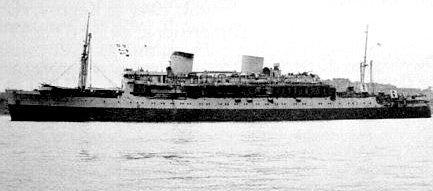
Wartime Heritage
ASSOCIATION

Forty-two ships carrying Canadian soldiers departed Great Britain on June 25, 1943. On board were the 1st Canadian
Infantry Division and the 1st Canadian Army Tank Brigade. The soldiers didn’t know where they were going, and it was not until
July 3, 1943, as they passed through the Straits of Gibraltar that they learned they were to be part of an Allied invasion of Sicily.
On June 28 a second convoy group departed Great Britain. The 1st Canadian Division’s component of this convoy included ten
ships transporting the division’s three infantry brigades and the Three Rivers Tank Regiment.
1st Canadian Division in the two convoys numbered some 26,000 troops, with tanks, artillery, and supplies.
Two additional convoys would bring additional supplies and troops within days of the planned invasion … a total invasion force
of some 3000 ships and landing craft.
The assault convoy of June 25th encountered enemy submarine attacks and three ships were lost. The City of Venice and the
St. Essylt were lost on July 4, 1943, and MV Devis on July 5. Fifty-eight Canadians were lost in the attacks. A significant amount of
equipment was also lost. The divisional motor pool lost five hundred vehicles; and the loss of forty guns meant the division’s
artillery strength, particularly its anti-tank strength, was significantly reduced. Divisional Headquarters lost almost all of its
vehicles and signals equipment, and the Royal Canadian Army Medical Corps’ lost personnel, medical supplies, and vehicles.
The City of Venice was a steam passenger ship, constructed in 1924 and
owned by the Ellerman Lines Ltd, London. The ship was carrying 292 troops of
the 1st Canadian Division and ten naval personnel. A torpedo from U-409 struck
at 8:47 pm and resulting explosions ignited fires. The Captain ordered most of
the 158 crew members, 22 gunners and all passengers to abandon ship in six of
the lifeboats. As fire began to spread rapidly and because of eminent danger of
the flames reaching the ammunition magazine and petrol the Captain decided
the remaining crew should abandon the ship. The Captain, eight crew members,
one gunner and ten military passengers, including the officer in command of the
troops, were lost. The City of Venice sank at 5:30 am on 5 July. The landing
craft HMS LCE-14 was lost with the ship.
HMS Teviot (K 222) picked up a total of 204 survivors, the remaining being rescued by HMRT Restive (W 39) and HMS
Rhododendron (K 78). The survivors were all landed at Algiers on 5 July.
The St. Essylt was a British Motor merchant ship constructed in 1940 and
owned by the South American Saint Line, Cardiff. The ship was carrying 322
troops, 900 tons of military stores and two landing craft (LCM). At 9:40 pm on
July 4, the ship was struck by a torpedo fired from U-375. The ship caught fire
and was abandoned. It sank at 5:45 am on July 5. One crew member, one
gunner and two passengers were lost. The master, fifty-three crew members,
twenty- three gunners and three hundred and twenty military personnel were
rescued and landed at Algiers. HMS Honeysuckle (K 27) picked up two hundred
and seventy-six survivors and the remaining men were picked up by
HMS Rhododendron (K 78).
MV Devis was a British Motor merchant ship modified as an Assault
Command Ship. Built in 1938, the ship was owned by Lamport & Holt Ltd,
Liverpool and was carrying two hundred eight-nine troops, four thousand tons of
government stores and a deck cargo of two landing craft.
At 2:43 pm hours on July 5, U-593 fired two spreads of two torpedoes at
convoy KMS-18B northeast of Cape Bengut and heard a hit after 1 minute 20
seconds and sinking noises. A torpedo fired by U-593 hit and sank the Devis . 52
soldiers were lost. HMS LCM-1123 sank with the ship, while HMS LCM-1129
floated off slightly damaged and was salvaged by its crew. The master, convoy
commodore, six naval staff members, 24 crew members, 21 gunners and 237 soldiers were picked up by HMS Cleveland (L 46) and
landed at Bougie.
Among the lost were Gunner Raymond John Ashe, (1st Anti-Tank Regiment, Royal Canadian Artillery) of Springhill, NS,
Private George William Barter, (West Nova Scotia Regiment) of Antigonish Co., NS, Sapper Walter Forsyth Currie, (4th Field
Company, Royal Canadian Engineers) of Kentville, King's Co., NS, and Private Leslie James Smith, (West Nova Scotia Regiment) of
Annapolis Co., NS. Their four names are listed on the Cassino Memorial.
Signalman Daniel Smith, (The Royal Canadian Corps of Signals) of Victoria Co., NS and Private Everett
Rupert James (West Nova Scotia Regiment) of Lunenburg Co., NS were also lost. Private James died on July 7,
having suffered severe burns during the attack on the convoy. Both are buried in La Reunion War Cemetery,
Algeria.
New Canadian units joined the Eighth Army’s order of battle when Canada dispatched an additional division to the
Mediterranean theatre, the 5th Armoured Division.
Convoy KMF 25A, consisting of forth-three ships, departed from Liverpool, England. The convoy included the the SS Santa
Elena and the Monterey. On November 6, 1943, German aircraft attacked the convoy and the Santa Elena was struck by a torpedo
and abandoned.
The American troop transport, SS Santa Elena built in
1933 was owned by Grace Line Inc. - W. R. Grace & Co. The ship
was attacked and torpedoed by German aircraft about twenty-
seven miles off Phillippeville, The ship was transporting 1,870
Canadian troops and nurses en route to Naples. The ship was
abandoned.
The Transport ship Monterey took on board the 1,870
Canadian troops and nurses travelling on the SS Santa Elena.
Abandoned, the SS Santa Elen was still floating the next day and
was taken under tow. The SS Santa Elena was then accidentally rammed by a Dutch transport in a collision. Taken under tow again
but could not take the strain and the SS Santa Elena sank off Phillipville, Tunisia, North Africa.

copyright © Wartime Heritage Association
Website hosting courtesy of Register.com - a web.com company
Italian Campaign Convoys - WWII
June / October 1943




Daniel Smith



- World War I - Menu
- WWI Stories and Articles
- Photos - Yarmouth Soldiers
- Selection of World War I Songs
- WWI Casualties of Yarmouth, NS
- Those Who Served - Yarmouth, NS
- WWI Casualties Digby Co. NS
- WWI Casualties Shelburne Co. NS
- Merchant Mariners (1915) Yarmouth, NS
- Canadian Forestry Corps - Non Yarmouth Birth/Residence Enlistments
- US Draft Registry - Yarmouth NS Born


- World War II - Menu
- WWII Stories and Articles
- Telegraphist Air Gunners
- WWII Casualties of Nova Scotia
- US Casualties with NS Connection
- Far East/Pacific Casualties with NS Connection
- Merchant Navy Casualties Nova Scotia
- Nova Scotia WWII Casualties Holten Canadian War Cemetery
- D-Day Casualties - Nova Scotia
- CANLOAN Program Casualties - Nova Scotia
- Battle of the Bulge Casualties - Nova Scotia
- WWII Casualties Yarmouth NS
- Yarmouth Casualties - RCAF RAF Canadian Army WWII
- Yarmouth Co., Marrages WWII
- Casualties Non-Born/Residents with Connection to Yarmouth Co., Nova Scotia.
- WWII Casualties Digby Co., NS
- Non-Nova Scotian WWII Casualties Buried in Nova Scotia
- WWII RCAF Casualties Aged 16-18
- Brothers/Sisters Who Served - World War II













